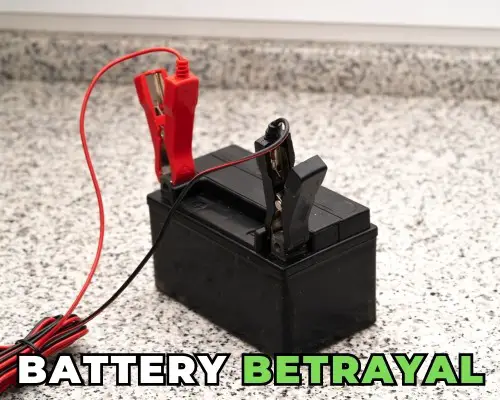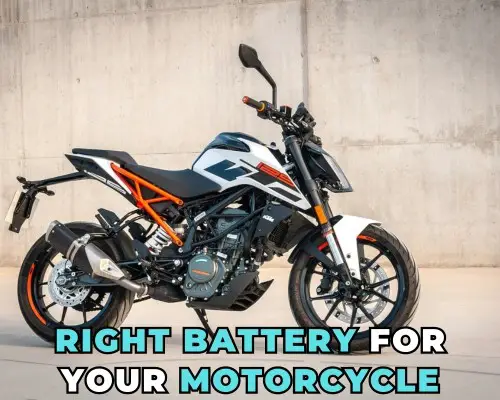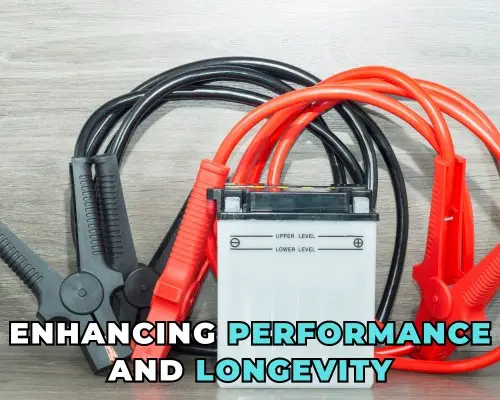Ever set out for a thrilling ride, only to halt with a sputter? Not a fun surprise, right? Picture this: a perfect riding day turns sour, all thanks to a dead battery. It’s a common grief among riders.
A motorcycle isn’t just a bike; it’s your ticket to freedom—unless the battery fails. Think about it. You’ve planned your route, and geared up, but your bike won’t start. The issue often isn’t just a faulty battery; it’s a neglected one.
Are you checking your battery regularly? Or do you find out it’s dead only when you try to start your ride? Let’s delve into how you can avoid this pitfall and ensure your motorcycle is ready when you are.
How to AVOID Getting Stranded with a Dead Motorcycle Battery – Beginner’s Guide

Understanding the Types of Motorcycle Batteries
Wet Cell Batteries (Type 1): Picture the old faithful of batteries. While they’re cheaper, they’re like a high-maintenance relationship.
You need to check their fluid levels often, like ensuring a plant has enough water, and watch out for potential acid leaks. They’re less suited for neglect but great for regular riders who can attend to their needs.
Dry Cell Batteries (Type 2): Think of these as the low-maintenance companions. They come sealed, so you say goodbye to top off water.
Though pricier, they offer peace of mind with stronger performance and longevity. Ideal for those who demand reliability without the fuss.
Gel Cell Batteries (Type 3): These are the elite troops, ready for rough terrains and extreme conditions. The gel within resists vibrations and temperature extremes, making them perfect for adventure seekers. The cost is higher, but for riders in challenging environments, it’s a worthy investment.
Charging and Maintaining Your Motorcycle Battery
Use the Correct Charger: It’s like feeding your pet the right diet. Match the charger to the battery type to avoid damaging your battery’s health.
Monitor the Battery’s State of Charge: Employ a multimeter or battery tester as you would use a thermometer for a fever.
Regular checks can prevent the misery of under or overcharging—common pitfalls that shorten battery life.
Avoid Deep Discharging: It’s akin to not letting your phone die completely. Keep your battery charged; deep cycles wear it out faster.
Store Your Motorcycle Properly: During off-seasons, treat your bike like a bear in hibernation. A fully charged, disconnected battery avoids unnecessary drain and damage.
Check the Battery’s Age: Batteries age, not like fine wine but more like spices. Most have a spice rack life of 3-5 years. Post that, they’re less potent and reliable.
Avoiding Battery-Related Issues
Use a Battery Tender: This device is like a caretaker for your battery when you’re away. It keeps the battery in optimal condition, extending its life and readiness.
Avoid Extreme Temperatures: Batteries, like us, prefer comfort. Extreme cold or heat stresses them. Use a battery blanket in cold climates and seek shade in hot areas.
Use a High-Quality Battery: Investing in a premium battery is like choosing a reliable friend. Opt for reputable brands that promise endurance and performance.
Keep Your Motorcycle Clean: A clean bike isn’t just about looks—it prevents grime from clogging up essential parts. Regular cleaning helps the battery and the bike.
Choosing the Right Battery for Your Motorcycle

Selecting the idealize battery for your bike isn’t fair a box-checking exercise—it’s approximately coordinating your bike’s heart with its way of life. Let’s jump more profound into making the most excellent choice for your ride.
How to Select the Best Battery for Your Bike’s Needs
Understanding Your Motorcycle’s Specific Needs:
- Type of Motorcycle: Just like you wouldn’t wear flip-flops to hike, different bikes need different batteries. For a high-performance sports bike, a robust battery like a high-capacity AGM can handle the high energy demands.
Contrastingly, a classic or vintage bike may require a lower-voltage battery to maintain authenticity and functionality.
- Riding Frequency: How often you ride can greatly influence your choice. For the daily commuter, a durable and maintenance-free battery ensures readiness each morning.
However, for the weekend warrior, a reliable gel battery might be sufficient, offering long idle times without losing charge.
- Battery Types: AGM batteries might cost more upfront but think of them as an investment in hassle-free riding.
Gel batteries, on the other hand, are perfect for those who brave extreme conditions as they resist vibration and temperature changes superbly.
Key Considerations:
- Capacity and Voltage: Did you know that selecting a higher capacity than your bike requires can extend battery life? It’s like having a larger tank of energy to draw from, which can be particularly useful for those with additional accessories like GPS systems or heated grips.
- Maintenance Level: Consider how hands-on you want to be. Conventional batteries are cheaper but think of them as pets needing your constant attention—checking water levels, ensuring they’re charged.
In contrast, maintenance-free batteries ask nothing more from you than installation and a periodic check with a voltmeter.
- Quality vs. Cost: Don’t let price alone guide you. A reputable brand might charge more but offers peace of mind with reliability and warranty coverage. It’s like buying insurance for your road trips.
Comparing Battery Brands: What’s Worth Your Money?
Evaluating Brand Quality:
- Reliability and Trust: A battery’s brand should stand behind its product with robust support and a solid warranty.
Look for brands that offer at least a three-year warranty, which speaks volumes about their confidence in the product.
- Warranty and Support: It’s like having a good mechanic friend. A supportive warranty and responsive customer service can save you time, money, and headaches down the road.
Always check how comprehensive the warranty is—does it cover replacement, and is there pro-rata coverage?
Value Evaluation:
- Cost vs. Features: Like choosing a smartphone, the most expensive isn’t always the best for you. Weigh features against cost.
Is the extra expense for a premium battery justified by extended warranty periods or superior cold-cranking amps (CCA) ratings?
- Customer Insights: Dive into forums, read reviews, and talk to fellow riders. There’s no substitute for first-hand experiences.
Real-world feedback can reveal how batteries perform in the wild and what quirks might come with them.
Perfect Compatibility:
- Bike and Battery Match: Always double-check compatibility. An incompatible battery can lead to power mismatches, potentially damaging your bike’s electrical system.
Ensure the battery fits not just physically but also suits the bike’s voltage requirements and charging capabilities.
Choosing the right battery involves understanding your needs, evaluating options, and considering long-term value.
It’s about finding the perfect match that promises reliability, supports your riding lifestyle, and keeps your bike ready for the road whenever you are. Remember, the right choice here illuminates your path, not just powers your ride.
Routine Maintenance and Care

Legitimate care and schedule checks are fundamental not as it were for expanding the life expectancy of your motorcycle’s battery but also for guaranteeing each ride is smooth and secure. Here’s how you’ll be able to expertly keep up your motorcycle’s battery and keep it in top condition.
Regular Battery Checks: A Simple How-To
Monitoring State of Charge:
- Use the Right Tools: Think of your multimeter or battery tester as your bike’s best friend. Regular checks are the equivalent of checking the pulse of your bike’s electrical system.
A healthy battery should read around 12.6 volts when fully charged. Regularly catching a voltage drop early can be the difference between a quick charge and being stranded.
- Interpreting Signs: Consistent readings below 12 volts often indicate a battery in distress, potentially needing more than just a charge. It’s like catching a cold; early treatment can prevent more serious issues.
Inspecting Battery Terminals:
- Routine Cleaning: Erosion at the terminals is like cholesterol in courses; it squares the vitality stream.
Blend a small preparing pop with water to make a cleaning glue. Utilize a toothbrush for hard-to-reach spots, guaranteeing no buildup builds up.
- Tight and Tidy Connections: Just as you check the tightness of your shoe laces before a run, make sure the connections are secure.
Even small vibrations can loosen them over time, which can lead to power loss and erratic bike behavior.
Water Levels and Battery Age:
- Maintaining Fluid Levels: Only use distilled water to refill wet cell batteries; tap water can introduce minerals that might degrade the battery’s internal structure.
- Age and Efficiency: Batteries generally have a performance shelf life of about 3-5 years. However, frequent short trips that don’t allow the battery to fully charge can shorten this lifespan. Think of it like exercise for humans; regular, full cycles keep a battery healthy.
The Importance of Keeping Your Battery Clean and Dry
Regular Cleaning:
- Soft Cleaning Techniques: Use a damp cloth with a mild detergent to gently clean the battery case.
This prevents dirt from becoming a conductor, which can drain battery power or even cause a short.
- Steer Clear of Abrasives: Avoid harsh chemicals and rough brushes that can damage the battery’s surface. Treat the battery casing as you would the lens of a camera.
Ensuring Dryness:
- Thorough Drying: After any cleaning or exposure to moisture, ensure the battery is thoroughly dried. Moisture is the enemy of longevity in battery life, leading to corrosion and other issues.
- Check for Seals: Make sure the battery cover and any vent caps are securely in place to protect against moisture ingress.
Proper Storage:
- Optimal Storage Conditions: In case putting away your bike for an amplified period, keep the battery in a cool, dry put absent from coordinated daylight and extraordinary temperatures. Extraordinary cold or warm can quicken the corruption of the battery.
- Charge Before Storing: Completely charge the battery sometime recent capacity and consider employing a battery delicate that can consequently keep up the charge without cheating.
It’s like putting your bicycle on life back, guaranteeing it wakes up solid and prepared to go.
Enhancing Performance and Longevity

Upgrading your motorcycle’s battery isn’t almost choosing the correct model; it’s around contributing to innovation that advances along with your riding needs.
Let’s extend our understanding of how key overhauls and cutting-edge developments can lift your biking encounter.
Upgrades and Accessories for Battery Optimization
Choosing High-Capacity Batteries:
- Why Go Bigger? Think of a high-capacity battery as your bike’s endurance trainer. It’s designed not just for longer rides but for managing multiple accessories like GPS systems and heated gear without breaking a sweat.
This is like upgrading from a day pack to an expedition backpack when planning longer trips.
- Longevity and Performance: These batteries are built to endure not just longer periods of use, but also the frequent charge and discharge cycles that come with intense riding schedules.
They degrade slower than standard batteries, giving you more ride time and less downtime.
Implementing Battery Management Systems (BMS):
- The Heartbeat of Your Battery: A BMS doesn’t just monitor; it actively manages your battery’s health.
It’s like having a personal mechanic inside your battery, constantly adjusting settings to improve life and performance.
- Preventive Care: With features like temperature control and voltage regulation, a BMS can dramatically reduce the wear and tear on your battery, prolonging its life by up to 40%. It’s an investment in longevity.
Using Battery Tenders and Smart Chargers:
- Maintain Charge Without Effort: Battery tenders and smart chargers are the vigilant guardians of your battery’s charge state.
They intelligently adjust the charge rate, depending on the battery’s condition and ambient temperature.
- Avoiding the Pitfalls of Overcharging: These devices are essential for preventing the battery stress that comes from overcharging, which is akin to overfilling a balloon—eventually, it bursts.
Installing Battery Isolators and Disconnects:
- No More Parasitic Drain: Battery isolators sever the connection when your bike is off, ensuring that secondary systems don’t drain your main battery.
It’s akin to turning off the water when you brush your teeth—saving vital resources.
- Simple Security: Disconnects provide a simple, foolproof way to manage your battery’s charge. They can be a real lifesaver, especially during long storage periods.
Technology and Innovations in Motorcycle Batteries
Advanced Battery Materials:
- Next-Gen Tech: Batteries developed from lithium-ion or nickel-metal hydride are not fair lighter; they pack a more productive punch.
For occurrence, lithium-ion batteries can be up to 30% lighter than conventional lead-acid batteries advertising longer life expectancies and speedier revive times.
- The Efficiency Edge: These advanced materials also mean better energy density and reduced environmental impact, which translates to fewer charges and a smaller carbon footprint.
Smart Batteries and Integrated Systems:
- Batteries That Communicate: Smart batteries with integrated BMS and telemetry capabilities allow you to monitor their health via smartphone apps.
This is like having a direct line to your bike’s power center, providing updates on condition and needs.
- Customizable Alerts: Set alerts for low charge, high temperature, or when it’s time for maintenance. It’s personalized care at its best, ensuring you never miss a beat.
Innovative Charging Solutions:
- Remote Charging: Envision pulling up to your carport and having your bicycle consequently begin charging—no plugs, no bother, fair comfort.
- Regenerative Braking: This technology not only helps conserve fuel but also recharges your battery while you ride, capturing energy typically lost during braking. It’s like having a recycling system for energy.
As an Amazon Associate, I earn from qualifying purchases, at no additional cost to you. Read Our Affiliate Disclosure.

